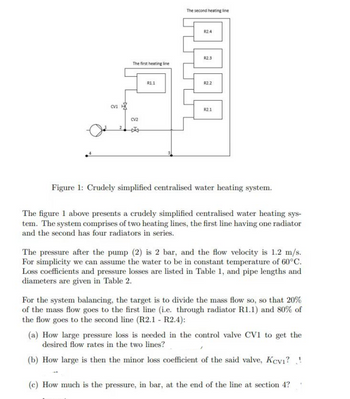
College Physics
11th Edition
ISBN: 9781305952300
Author: Raymond A. Serway, Chris Vuille
Publisher: Cengage Learning
expand_more
expand_more
format_list_bulleted
Question
![Also, for simplicity we can assume the pipes to be hydraulically smooth and
estimate the friction factors with the Blasius correlation
f =
0.3164
Re¹/4
Table 1: Minor loss coefficients and pressure losses
Equipment
T-junction after the pump, flow going directly
T-junction after the pump, flow going to the branch
Control valve CV2
90° bend
Pressure loss in a single radiator
Combining t-junction, flow going directly
Combining t-junction, flow coming from the branch
Section
Pump → t-junction
t-junction
radiator R1.1
radiator R1.1 → t-junction
t-junction radiator R2.1
radiator R2.1
radiator R2.2
radiator R2.2→ radiator R2.3
radiator R2.3 →→ radiator R2.4
radiator R2.4 → t-junction
t-junction end
Table 2: Pipe lengths and diameters
6
6
24
12
4
4
Minor loss coefficient, K
4
24
12
Length [m] Inner pipe diameter [mm]
22
12
12
18
18
18
0.9
2
18
18
22
12
0.7
4 kPa
0.9
2
(1)](https://content.bartleby.com/qna-images/question/ad189bf0-3946-4d02-81d7-fb79d450939f/a0e618e7-058f-4fbb-bb05-115312fbd03f/ic6gr8k_thumbnail.png)
Transcribed Image Text:Also, for simplicity we can assume the pipes to be hydraulically smooth and
estimate the friction factors with the Blasius correlation
f =
0.3164
Re¹/4
Table 1: Minor loss coefficients and pressure losses
Equipment
T-junction after the pump, flow going directly
T-junction after the pump, flow going to the branch
Control valve CV2
90° bend
Pressure loss in a single radiator
Combining t-junction, flow going directly
Combining t-junction, flow coming from the branch
Section
Pump → t-junction
t-junction
radiator R1.1
radiator R1.1 → t-junction
t-junction radiator R2.1
radiator R2.1
radiator R2.2
radiator R2.2→ radiator R2.3
radiator R2.3 →→ radiator R2.4
radiator R2.4 → t-junction
t-junction end
Table 2: Pipe lengths and diameters
6
6
24
12
4
4
Minor loss coefficient, K
4
24
12
Length [m] Inner pipe diameter [mm]
22
12
12
18
18
18
0.9
2
18
18
22
12
0.7
4 kPa
0.9
2
(1)

Transcribed Image Text:CV1
2
The first heating line
3
CV2
R1.1
The second heating line
R2.4
R2.3
R2.2
R2.1
Figure 1: Crudely simplified centralised water heating system.
The figure 1 above presents a crudely simplified centralised water heating sys-
tem. The system comprises of two heating lines, the first line having one radiator
and the second has four radiators in series.
The pressure after the pump (2) is 2 bar, and the flow velocity is 1.2 m/s.
For simplicity we can assume the water to be in constant temperature of 60°C.
Loss coefficients and pressure losses are listed in Table 1, and pipe lengths and
diameters are given in Table 2.
For the system balancing, the target is to divide the mass flow so, so that 20%
of the mass flow goes to the first line (i.e. through radiator R1.1) and 80% of
the flow goes to the second line (R2.1 - R2.4):
(a) How large pressure loss is needed in the control valve CV1 to get the
desired flow rates in the two lines?
(b) How large is then the minor loss coefficient of the said valve, Kevi?!
(c) How much is the pressure, in bar, at the end of the line at section 4?
Expert Solution
This question has been solved!
Explore an expertly crafted, step-by-step solution for a thorough understanding of key concepts.
This is a popular solution
Trending nowThis is a popular solution!
Step by stepSolved in 2 steps with 2 images

Knowledge Booster
Learn more about
Need a deep-dive on the concept behind this application? Look no further. Learn more about this topic, physics and related others by exploring similar questions and additional content below.Similar questions
- This is a calculation only. Energy2d isn’t able to do phase changes as far as I’ve learned. There was a different simulation for this but it is not currently free. You combine 50g of ice at -10oC with 150g of liquid water at 75oC. After a few minutes, you measure the final equilibrium temperature of all of the H2O to be 35.1 oC. Use this information to “experimentally” determine the heat of transformation of water, Lfusion. cwater=4190 J/kgK, cice=2090 J/kgK Show all of your work and compare to the accepted value Lfusion=3.33x105 J/kg.arrow_forwardI am doing an experiment on calculate latent heat from a kettle. I calculate the latent heat against time. I was hoping to see the it would remain constant. So I plotted 2 graphs the mass of evaporated water and the calculated latent heat. Could you explain to me why my caluclate latent heat graph is a polynomial while the mass change is linear?arrow_forward
arrow_back_ios
arrow_forward_ios
Recommended textbooks for you
 College PhysicsPhysicsISBN:9781305952300Author:Raymond A. Serway, Chris VuillePublisher:Cengage Learning
College PhysicsPhysicsISBN:9781305952300Author:Raymond A. Serway, Chris VuillePublisher:Cengage Learning University Physics (14th Edition)PhysicsISBN:9780133969290Author:Hugh D. Young, Roger A. FreedmanPublisher:PEARSON
University Physics (14th Edition)PhysicsISBN:9780133969290Author:Hugh D. Young, Roger A. FreedmanPublisher:PEARSON Introduction To Quantum MechanicsPhysicsISBN:9781107189638Author:Griffiths, David J., Schroeter, Darrell F.Publisher:Cambridge University Press
Introduction To Quantum MechanicsPhysicsISBN:9781107189638Author:Griffiths, David J., Schroeter, Darrell F.Publisher:Cambridge University Press Physics for Scientists and EngineersPhysicsISBN:9781337553278Author:Raymond A. Serway, John W. JewettPublisher:Cengage Learning
Physics for Scientists and EngineersPhysicsISBN:9781337553278Author:Raymond A. Serway, John W. JewettPublisher:Cengage Learning Lecture- Tutorials for Introductory AstronomyPhysicsISBN:9780321820464Author:Edward E. Prather, Tim P. Slater, Jeff P. Adams, Gina BrissendenPublisher:Addison-Wesley
Lecture- Tutorials for Introductory AstronomyPhysicsISBN:9780321820464Author:Edward E. Prather, Tim P. Slater, Jeff P. Adams, Gina BrissendenPublisher:Addison-Wesley College Physics: A Strategic Approach (4th Editio...PhysicsISBN:9780134609034Author:Randall D. Knight (Professor Emeritus), Brian Jones, Stuart FieldPublisher:PEARSON
College Physics: A Strategic Approach (4th Editio...PhysicsISBN:9780134609034Author:Randall D. Knight (Professor Emeritus), Brian Jones, Stuart FieldPublisher:PEARSON

College Physics
Physics
ISBN:9781305952300
Author:Raymond A. Serway, Chris Vuille
Publisher:Cengage Learning

University Physics (14th Edition)
Physics
ISBN:9780133969290
Author:Hugh D. Young, Roger A. Freedman
Publisher:PEARSON

Introduction To Quantum Mechanics
Physics
ISBN:9781107189638
Author:Griffiths, David J., Schroeter, Darrell F.
Publisher:Cambridge University Press

Physics for Scientists and Engineers
Physics
ISBN:9781337553278
Author:Raymond A. Serway, John W. Jewett
Publisher:Cengage Learning

Lecture- Tutorials for Introductory Astronomy
Physics
ISBN:9780321820464
Author:Edward E. Prather, Tim P. Slater, Jeff P. Adams, Gina Brissenden
Publisher:Addison-Wesley

College Physics: A Strategic Approach (4th Editio...
Physics
ISBN:9780134609034
Author:Randall D. Knight (Professor Emeritus), Brian Jones, Stuart Field
Publisher:PEARSON